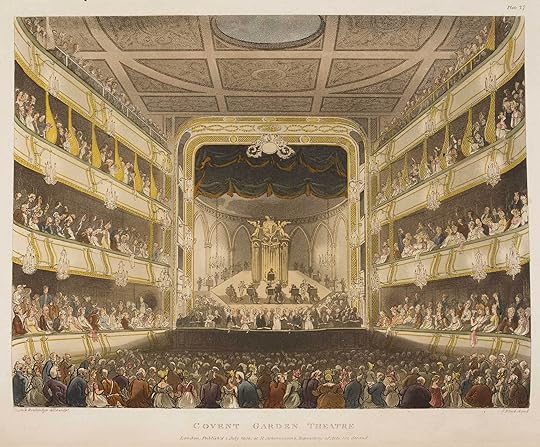Dickensians! discussion

This topic is about
The Strange Gentleman
Dramatic Dickens! Year
>
The Strange Gentleman: A Comic Burletta, in Two Acts (hosted by Connie)
message 1:
by
Bionic Jean, "Dickens Duchess"
(last edited Jan 31, 2024 10:04AM)
(new)
-
added it
Jan 31, 2024 03:40AM
 Mod
Mod
reply
|
flag
 THE STRANGE GENTLEMAN
THE STRANGE GENTLEMAN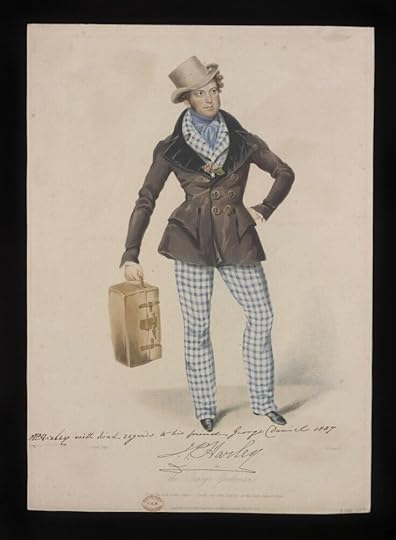
Actor J P Harley as the Strange Gentleman
Drawn by James Childe, engraved by Reginald Easton
from the Victoria and Albert Museum
https://collections.vam.ac.uk/item/O1...
 Dramatic Dickens
Dramatic DickensOne of the great things about the Dickensian group is that we've had the wonderful experience of reading such a varied range of Dickens' literary work. We can remember works that have had elements of the sentimental, melodrama, social justice, observations about life, news of his time, travel experiences, historical information, satire and other humor, the supernatural, and just plain good storytelling. So I'm delighted that the group will be spending some time on the dramatic Dickens this year--his love of the theatre, his plays, and the incorporation of theatrical elements in his other writing.
The Strange Gentleman: A Comic Burletta, in Two Acts is Dickens' first play that was performed publicly for a professional theatre. Dickens adapted a comic short story, The Great Winglebury Duel, from his collection, Sketches by Boz. The resulting lighthearted comic play was The Strange Gentleman: A Comic Burletta, in Two Acts which was staged at the St James' Theatre in 1836.
 Farce
FarceThe Strange Gentleman: A Comic Burletta, in Two Acts is a farce with entertainment as its goal. A farce might use mistaken identities, miscommunication, desperation, improbable situations, and broad physical humor. Timing is everything in a farce, and the title role was performed by an experienced, popular comic actor, J P Harley, in 1836.
As we read this play, it will be fun to imagine in our minds how comic actors will portray their roles onstage. These articles tell about the elements of farce, and give some examples of farce in literature:
https://www.supersummary.com/farce/
https://broadwayeducators.com/tips-fo...
 Where to Find a Copy of the Play
Where to Find a Copy of the PlayThe Strange Gentleman: A Comic Burletta, in Two Acts is included in some "Complete Works of Dickens" e-books, but you have to check the table of contents carefully. It also comes as a single book, but the complete works is a bargain in the long run.
For Kindle Users:
Complete Works of Dickens
https://www.amazon.com/Charles-Dicken...
For Nook Users:
Delphi Complete Works of Charles Dickens
https://www.barnesandnoble.com/w/delp...
Single Delphi The Strange Gentleman
https://www.barnesandnoble.com/w/the-...
LibriVox audiobook on youtube runs about 80 minutes. I suggest that you also have a written copy so it will be easier to remember when to stop reading each day.
https://www.youtube.com/watch?v=Ziz6u...
Internet Archive has a copy of the original book which can be downloaded or printed as a pdf of around 50 pages:
https://archive.org/details/strangege...
There are also paper books with the single play or a collection of plays such as:
Dickens the Dramatist: Plays by Charles Dickens
https://www.amazon.com/Dickens-Dramat...
Charles Dickens - The Strange Gentlemen: "A very little key will open a very heavy door." (available on amazon as a paperback or an e-book)
 Schedule
ScheduleThis is the first time that we will be looking at Dickens as a playwright. I'm planning on spending a few days on background material about the types of theatres in England in the 1830s, the challenges presented due to English laws, and Dickens' lifelong love of the theatre.
I'm listing the dates in London time, but I usually will be posting the evening before in Eastern US time.
Feb 7, 8, 9 Background material about the theatre in England, Dickens' passion for the theatre.
Feb 10 Act 1, Scene 1 begins (message 46)
end at "He's a wonderful man to talk, ma'am--keeps on like a steam engine. Here he is, ma'am."
Feb 11 Act 1, Scene 1 continues (message 65)
end at "I never saw such an extraordinary person in all my life. What can he be?"
Feb 12 Act 1, Scene 1 continues (message 81)
end at "Now if I can find any one who will deliver it secretly."
Feb 13 Act 1, Scene 1 continues (message 95)
end at "And then it's a chance whether they'd take me in, being so much overweight."
Feb 14 Act 1, Scene 1 continues (message 99)
end at "But just assist me first, dear, in making a little noise to attract his attention, if he really be in the next room, or I may wait here all day." (Sing Duet)
Feb 15 Act 1, Scene 1 continues (message 108)
end at "Hold him fast!" (end of Scene 1)
Feb 16 Act 1, Scene 2 begins (message 118)
end at "Very good--very good indeed--Excellent notion!" (end of Scene 2)
Feb 17 Act 1, Scene 3 begins (message 125)
end at "Knowing trick indeed, my Lord, very!"
Feb 18 Act 1, Scene 3 continues (message 133)
end at "I'm dumb, Mr Boots--dumb, sir." (Scene 3 ends)
Feb 19 Act 2, Scene 1 begins (message 141)
end at "How well he does it!"
Feb 20 Act 2, Scene 1 continues (message 149)
end at "His senses have entirely left him." (Scene 1 ends)
Feb 21 Act 2, Scene 2 begins (message 158)
end at "I can't help thinking it's No. 23.--Hallo!"
Feb 22 Act 2, Scene 2 continues (message 163)
end at "Some more lunatics."
Feb 23 Act 2, Scene 2 continues (message 175)
to the end of the play
I'm looking forward to the start of this discussion on February 7th!
 Connie, what a great idea to start at the very beginning with his first play that was brought to the stage. I'm looking forward to reading a new genre of Dickens writing. We all know how much he loved the theater.
Connie, what a great idea to start at the very beginning with his first play that was brought to the stage. I'm looking forward to reading a new genre of Dickens writing. We all know how much he loved the theater.I love the illustration of JP Harley. He's quite fancy in those checkered pants. He does have the look of a "strange gentleman".
I'm off now to investigate the links you gave us about farce! Thanks for that.
 Bridget wrote: "Connie, what a great idea to start at the very beginning with his first play that was brought to the stage. I'm looking forward to reading a new genre of Dickens writing. We all know how much he lo..."
Bridget wrote: "Connie, what a great idea to start at the very beginning with his first play that was brought to the stage. I'm looking forward to reading a new genre of Dickens writing. We all know how much he lo..."I have to give Jean the credit for the Dramatic Dickens theme. I'm happy you will be reading "The Strange Gentleman" with us, Bridget!.
Who else is able to join in with this, and like me is intrigued to meet the strange gentleman?
He looks a bit of a dandy doesn't he, and does he have the air of a rogue about him, do you think? I wonder what he is carrying. 🤔
Connie has suggested lots of places where you might find this piece, and been very busy finding interesting snippets out for us. It does sound fun, thanks Connie!
Just one more day ... then it all kicks off on Wednesday (according to Connie's schedule in comment 6) 🤩
He looks a bit of a dandy doesn't he, and does he have the air of a rogue about him, do you think? I wonder what he is carrying. 🤔
Connie has suggested lots of places where you might find this piece, and been very busy finding interesting snippets out for us. It does sound fun, thanks Connie!
Just one more day ... then it all kicks off on Wednesday (according to Connie's schedule in comment 6) 🤩
 I am in and looking forward to it. I have other commitments but decided I will make room when I saw Connie was leading. I am going to listen to Librivox while reading and I think most of you can download from the librivox site if you want to use that method over Youtube. When at link, click on the part you wish to download, which should open a player window where you can download by clicking on the three dots to the right of the player.
I am in and looking forward to it. I have other commitments but decided I will make room when I saw Connie was leading. I am going to listen to Librivox while reading and I think most of you can download from the librivox site if you want to use that method over Youtube. When at link, click on the part you wish to download, which should open a player window where you can download by clicking on the three dots to the right of the player.https://librivox.app/book/6646
 Jean, you were wondering what the Strange Gentleman was carrying. That portmanteau actually belonged to Charles Dickens and he lent it to J P Harley for the show. The Dickens Letter Project has a letter from Feb 1837 (in the PS) where Dickens asks for his portmanteau back since he needs to pack it for a trip.
Jean, you were wondering what the Strange Gentleman was carrying. That portmanteau actually belonged to Charles Dickens and he lent it to J P Harley for the show. The Dickens Letter Project has a letter from Feb 1837 (in the PS) where Dickens asks for his portmanteau back since he needs to pack it for a trip. https://dickensletters.com/letters/jo...
 I plan on joining in this group read. So glad I found the competed works on Kindle. Haven't read any of his plays and looking forward to it.
I plan on joining in this group read. So glad I found the competed works on Kindle. Haven't read any of his plays and looking forward to it.
 Patent (or Legitimate) Theatres
Patent (or Legitimate) TheatresThe Licensing Act of 1737 restricted "spoken word" plays to two patent (or legitimate) theatres in London in the winter season--the Royal Theatre Covent Garden and the Royal Theatre Drury Lane. When they were closed in the summer, the Haymarket Theatre was open. All plays were censored with the approval of the Lord Chamberlain and his Examiners of Plays needed before the first performance.
What prompted this strict law? According to the Victoria and Albert Museum:
"The act was put in place by the then Prime Minister Robert Walpole (1676-1745), who was concerned that political satire on the stage was undermining him and the authority of the government. A production of 'The Golden Rump,' a farcical play of unknown authorship, was the chief trigger for Walpole pushing the case for banning obscene drama from the public arena. The play scandalously suggested that the Queen administered enemas to the King. Henry Fielding, author of a number of successful satires, and others were suspicious that this play had in fact been engineered by Walpole himself."
These monopolies on the performance of serious, spoken plays stayed in effect until the Theatres Act of 1843.
https://www.vam.ac.uk/articles/the-st...
https://en.wikipedia.org/wiki/Licensi...
 Popular (or illegitimate or minor) Theatres
Popular (or illegitimate or minor) TheatresNon-patent theatres had to include music in their plays or other events. They could also stage silent action events such as pantomine, animal acts, and acrobatics. But they were not allowed to perform Shakespeare or other straight spoken word plays.
As the middle class was rising, more people enjoyed going to the theatre. The minor theatres became popular since the ticket prices were lower, and it was easier to hear in the smaller theatres.
The term "burletta" which originally had been used for a farce with interpolated music, now became a label for any play which might be legally performed at a minor theatre--which was thus said to have a "burletta license." Songs and musical interludes were required before the Lord Chamberlain's Office would issue a license.
An evening at a popular theatre might include several events. The evening might open with a pantomine, then stage a melodrama, followed by a short musical work as they did their set changes, then a farce. Theatres often sold half-price tickets to late arriving patrons.
The large patent theatres had trouble filling their 3,000 seats with serious drama. They often staged spectacles--opera, lion tamers, and battles on horses--to increase their revenue. The illegitimate theatres felt that it was unfair that they had restrictions, but the patent theatres did not. The 19th Century illegitimate theatres found ways to water down the music regulation since the law was not very specific about the type of music needed, and that regulation was dropped with the Theatre Act of 1843.
Trussler, Simon, "The Cambridge Illustrated History of British Theatre," London and New York: Cambridge University Press, 1994, 212-225.
https://www.britishlibrary.cn/en/arti...
 The Layout of Theatres
The Layout of Theatres19th Century theatres had boxes along the sides, a gallery (balcony) in back, and the pit on the ground floor. The theatres were a place to be seen in your finery if you were seated in the box seats. The gallery usually had backless benches or standing room. The pit held the musicians in front, and standing room or benches. Theatres eventually started putting raised stalls with benches in the back of the pit and charged more for those pit seats. Benches with backs eventually replaced the backless benches in the theatres. Many theatres had separate entrances for those with tickets to the box seats. The theatres were noisy and a place to socialize. It was often difficult to hear in the days before microphones and sound systems.
In "The Victorian City," it was noted that some theatres had special rooms near the boxes or under the stage for prostitutes to bring their customers.
Flanders, Judith. "The Victorian City." New York: St Martin's Press, 2015, 405.
 I'll be posting more about theatres tomorrow--lighting, music, St James Theatre, etc. Comments or questions are always welcome.
I'll be posting more about theatres tomorrow--lighting, music, St James Theatre, etc. Comments or questions are always welcome.
This is absolutely fascinating Connie! "The Golden Rump" LOL! I knew Henry Fielding got into trouble, but he really sounds as though his nose had been put out of joint there, doesn't he?
So we should remember that this was the backdrop - the history almost within living memory - to what Charles Dickens was writing! Thank you 😊
Oh just to add, the old theatres in London's West End still have that design, and ladies still parade their furs and fine jewellery in selected best seats in the circle. The rest of us in the cheap seats are probably stuck in the top balcony, or the back stalls, or shoved behind a pillar!
So we should remember that this was the backdrop - the history almost within living memory - to what Charles Dickens was writing! Thank you 😊
Oh just to add, the old theatres in London's West End still have that design, and ladies still parade their furs and fine jewellery in selected best seats in the circle. The rest of us in the cheap seats are probably stuck in the top balcony, or the back stalls, or shoved behind a pillar!
One typical and very popular theatre of the time was Astley's Theatre, which comes into Charles Dickens's works quite often. There's a post about here it: LINK HERE in our group read of Bleak House, and one about Philip Astley himself in Plateresca's excellent lead of Somebody's Luggage. LINK HERE
(There are no spoilers in either of these, and both have pictures 😁)
Plus more about Astley's Amphitheatre, to get an idea of what theatres showed at the time, on wiki here: https://en.wikipedia.org/wiki/Astley%...
I'm really looking forward to more details on St. James Theatre etc., tomorrow, Connie!
(There are no spoilers in either of these, and both have pictures 😁)
Plus more about Astley's Amphitheatre, to get an idea of what theatres showed at the time, on wiki here: https://en.wikipedia.org/wiki/Astley%...
I'm really looking forward to more details on St. James Theatre etc., tomorrow, Connie!
 Thanks for all the interesting information about Astley's Amphitheatre, Jean. London was an exciting city in terms of entertainment with so many new theatres opening up during the 19th Century. The East End was closer to the shipyards, but the West End was considered to be a good area to build a new theatre for plays.
Thanks for all the interesting information about Astley's Amphitheatre, Jean. London was an exciting city in terms of entertainment with so many new theatres opening up during the 19th Century. The East End was closer to the shipyards, but the West End was considered to be a good area to build a new theatre for plays.There were also Song and Supper rooms, and music halls where people could enjoy eating supper at long tables while viewing various types of musical entertainment, and other small acts. Many of the music halls were in the East End. For the working class, there were less expensive pub/performance venues called "Free and Easies" which featured amateur singers. There seemed to be something for all the social and economic classes to enjoy.
 This is wonderful information Connie and Jean. I like knowing that the people with expensive seats still get dressed up for the theater in London, and in the cheap seats you don't have to ;-)
This is wonderful information Connie and Jean. I like knowing that the people with expensive seats still get dressed up for the theater in London, and in the cheap seats you don't have to ;-)It was fun to learn the floor seating was called "the pit". Today where the musicians sit is still called "the pit", and I always wondered why. I assumed it was because the musicians are sort of under the stage. But now I know it's leftover from 19th century theaters.
 Bridget wrote: "This is wonderful information Connie and Jean. I like knowing that the people with expensive seats still get dressed up for the theater in London, and in the cheap seats you don't have to ;-)
Bridget wrote: "This is wonderful information Connie and Jean. I like knowing that the people with expensive seats still get dressed up for the theater in London, and in the cheap seats you don't have to ;-)It w..."
Bridget, I don't know exactly when the term, "the pit," started, but it was used back in Shakespeare's Globe Theatre. (Coal miners also used the term for the mine.)
Back in the day when it was just standing room with lots of people pressed together (like on a subway), many theatres would not sell pit tickets to women. But that changed when benches were put in the area.
 St James's Theatre on King Street
St James's Theatre on King Street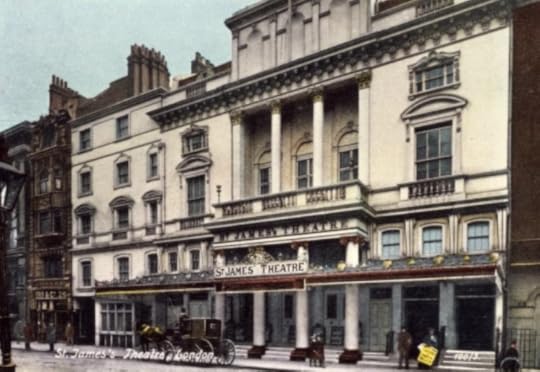
This 1200 seat theatre opened in December 1835. Dickens' "The Strange Gentleman," "The Village Coquettes," and "Is She His Wife?" were staged here. The theatre was designed by Samuel Beazley for John Braham, the tenor and theatre director. The theatre was in the West End of London. Dickens also did a series of dramatic readings at St James's Theatre in 1862. The theatre was knocked down in 1957 and replaced with an office block.
https://www.onlondon.co.uk/vic-keegan...
 Interior of St James's Theatre
Interior of St James's Theatre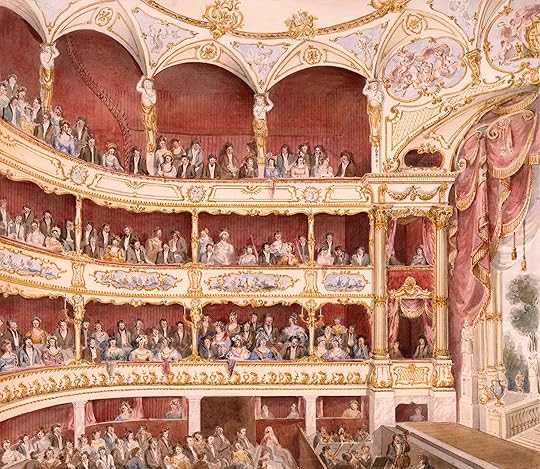
The theatre had a neo-classical exterior and a Louis XIV style interior decorated by the Frederick Crace Company. Wikipedia has a detailed quote about the interior from "The Times":
The prevailing colour is a delicate French white. A border of flowers, richly embossed in gold, runs round the dress circle, and has a tasteful and elegant effect. The panels of the boxes in the front of the first circle are ornamented by designs, in the style of Watteau, placed in gilded frames of fanciful workmanship. … The front of the slips and gallery are distinguished by neat gold ornaments, relieved by handsome medallions. The proscenium, which, like that of Covent-garden, is shell-form, is painted in compartments, where the loves and graces are depicted gaily disporting. Two slender fluted Corinthian columns, supported on pedestals of imitative marble, add greatly to the beauty of the stage-boxes. A series of arches, supporting the roof, and sustained by caryatides, runs entirely round the upper part of the theatre. ... The tout ensemble of the house is light and brilliant. It looks like a fairy palace. Then, the two great points which are most important to the comfort of an audience – hearing and seeing – have been sedulously consulted; and, with reference to them, we think that the new theatre takes the lead of all its brethren.
https://en.wikipedia.org/wiki/St_Jame...
 Lighting in the Early 19th Century
Lighting in the Early 19th CenturyUnlike theatres of today, the house lights were always on during the performance in the early 19th Century. The upper class wore their expensive outfits and hoped to be noticed. The well-lit atmosphere made people more prone to socialize.
Theatres were lit with candles or oil before 1817. Candle-burning chandeliers were hung low to light the stage, but they partly obstructed the view of the people in the gallery. Candles were also placed in sconces along the walls in the largest theatres. Oil was usually used in the footlights along the edge of the stage, a fire hazard especially for the actresses in long dresses.
Theatres changed to gas lighting after 1817. Gaslight made possible a greater degree of power and control in stage light, including realistic effects such as the illusion of sunlight, moonlight, or lamplight coming through the doors or windows of the sets. Limelight (calcium oxide, known as quick lime) was used to spotlight performers from 1837.
Electric light (arc lamps from 1848 and filament lamps from 1881) enabled the lighting crew to manage special effects better. The use of electric light also reduced the danger of fire. The Covent Garden Theatre burned in September 1808, and Drury Lane was destroyed by fire in February 1809, but those two large patent theatres were rebuilt. Numerous smaller theatres also experienced fires.
Tricks, Traps and Transformations: Illusion in Victorian spectacular theatre:
https://www.tandfonline.com/doi/abs/1...
Wikipedia Stage Lighting:
https://en.wikipedia.org/wiki/Stage_l...
 Musical Interludes During Set and Scenery Changes
Musical Interludes During Set and Scenery ChangesThe minor theatres were required to have music in their performances, so many used loud music to their advantage to cover the noise of set and scenery changes. Often the stage crew had to slide the scenery on and off using a series of grooves on the floor. Some theatres would attach wheels to the bottom of the painted wooden panels of the set, and roll it off the stage. Pulleys had to be cranked to lift characters giving the appearance of flying, or to have characters disappear below the stage. Moving panoramas--a setting painted on a long cloth--could be unrolled by the stage crew turning spools to show movement and a change of locale. So the directors of a show used the requirement for music by the Lord Chamberlain to hide noise as well as to advance the plot.
Victorian Playhouse and Production:
https://logicmgmt.com/1876/Victorian_...
 Dickens' Verses (Songs) for "The Strange Gentleman"
Dickens' Verses (Songs) for "The Strange Gentleman"Dickens wrote five verses for the play, but only the "Duet" in Act 1, Scene 1 was used. The "Duet" is mentioned on the playbill, but the music is lost.
Dickens submitted the play and the verses to the Lord Chamberlain's office for approval. Most of the songs were dropped during rehearsals. Perhaps musical interludes worked better than sentimental songs in keeping the mood comic and snappy. The St James's Theatre house musician, John Hullah, was also very busy composing music for Dickens' "The Village Coquettes" at that time.
The verses and the original play are now at the British Museum. The verses were transcribed from the Lord Chamberlain's Copy, 1836, by Emily Bell and Lydia Craig and can be found at:
https://dickenssearch.com/search?quer...
 Absolutely fascinating information, Connie. I enjoyed reading it and viewing all the images. I was celebrating that the British preserve their heritage and then a line later read that the St. James was knocked down in 1957. It has certainly become the trend here--the beautiful buildings of downtown Atlanta are almost entirely gone now.
Absolutely fascinating information, Connie. I enjoyed reading it and viewing all the images. I was celebrating that the British preserve their heritage and then a line later read that the St. James was knocked down in 1957. It has certainly become the trend here--the beautiful buildings of downtown Atlanta are almost entirely gone now.Thank you for all the copious research!
 Sara wrote: "Absolutely fascinating information, Connie. I enjoyed reading it and viewing all the images. I was celebrating that the British preserve their heritage and then a line later read that the St. James..."
Sara wrote: "Absolutely fascinating information, Connie. I enjoyed reading it and viewing all the images. I was celebrating that the British preserve their heritage and then a line later read that the St. James..."I've always loved attending the theatre, Sara, so I would have loved that aspect of living in London in the 19th Century. Those beautiful older buildings do have a special charm.
 Dickens' Childhood Love for the Theatre
Dickens' Childhood Love for the TheatreSince we are starting our readings for the "Dramatic Dickens," let's remember how important acting and theatre were in Dickens' life starting from his childhood. Dickens loved to sing and perform with his siblings at a young age. He also was an avid reader and especially enjoyed reading about heroes and villains. Their family's lodger, James Lamert, enjoyed taking the young boy to the little Theatre Royal at Rochester. When he got home, the eight-year-old would act out scenes from the plays with his friend next door.
The family had to move from Chatham to Camden for his father's job. When Dickens was ten years old, the family's debts were increasing so there were no more trips to the theatre, but he did amuse himself for hours playing with a toy theatre that James had built for him. But his world fell apart when his father went to debtor's prison, and Charles was sent to work at a blacking factory.
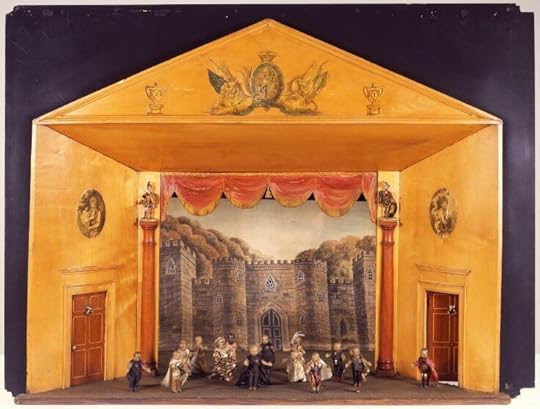
Wooden Toy Theatre from the Victoria and Albert Museum
https://collections.vam.ac.uk/item/O1...
There are some beautiful toy theatres to view in this article from the Guardian about a museum exhibit:
"Child's play: Miniature Regency and Victorian Theatres--in pictures"
https://www.theguardian.com/stage/gal...
 Dickens' Passion for the Theatre as a Young Man
Dickens' Passion for the Theatre as a Young ManDickens acted in some school plays at the Wellingon House Academy which he attended until age 15. Later, when he was working as a clerk in a law office, Dickens loved attending the shows of Charles Mathews who performed monopolylogues, farces where he played all the characters. Mathews would change costumes and use various dialects in his shows. Dickens would go home and practice his routines. He would entertain the clerks at the law office with his imitations of Mathews and other actors.
Dickens was interested in becoming an actor. When he was nineteen, he had an audition scheduled at Covent Garden, but a severe head cold kept him from keeping the appointment. He continued with his writing career, but also acted in many amateur performances, often for charity.
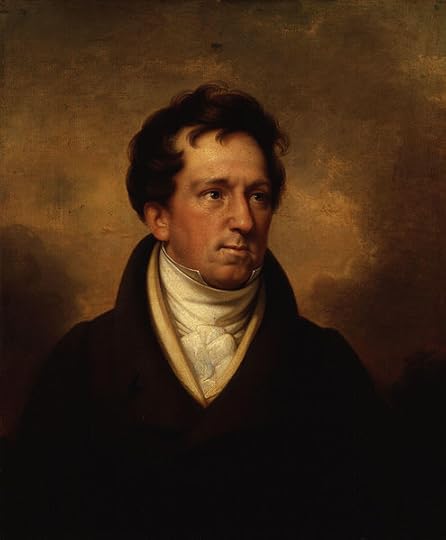
Charles Mathews by Rembrandt Peale, circa 1822
The 19th Century Comedy Routines of Charles Mathews-Shannon Selin
https://shannonselin.com/2021/05/19th...
Callow, Simon. "Charles Dickens and the Great Theatre of the World." New York: Vintage, 2012.
 Dickens Love for the Theatre Continued Lifelong
Dickens Love for the Theatre Continued LifelongIn his book, Charles Dickens and the Great Theatre of the World, Simon Callow wrote, "Literature was his wife, the theatre his mistress, and to the very end he was tempted to leave the one for the other." Even as Dickens was having a very successful writing career, he always took time to be involved in the theatre.
Dickens wrote the three plays for St James's Theatre and was very involved in their production. He also collaborated with other writers, such as Wilkie Collins, in writing plays. He continued acting occasionally with his friends, and instilled a love of theatre in his children.
Dickens included characters who were actors in several of his novels, but I'm not mentioning specifics to avoid spoilers. His books have a theatrical feeling to them so they were often pirated and adapted into plays, even before he had finished writing the serialized novels. There have been fantastic dramatic adaptations of his novels and his Christmas books for stage and film.
Dickens also did dramatic readings of excerpts from his plays on tours in Great Britain and America. He performed the various characters as he had learned as a young man watching Charles Mathews. Unfortunately, the reading tours were so exhausting and intense that they probably contributed to his death.
Fisher, Mike. Passion for theater shaped Charles Dickens. Milwaukee Journal Sentinel
https://archive.jsonline.com/entertai...
Callow, Simon. "Charles Dickens and the Great Theatre of the World." New York: Vintage, 2012.
 I'll post a summary of the first section of "The Strange Gentleman" tomorrow evening. I hope you enjoy reading it.
I'll post a summary of the first section of "The Strange Gentleman" tomorrow evening. I hope you enjoy reading it.
Sara wrote: "a line later read that the St. James was knocked down in 1957 ..."
I know! As I was enjoying Connie's excellent research, I thought to myself "Why is St. James's theatre not familiar?" as I know most of the theatres in the West End. I was so disappointed to hear that it doesn't exists any more! 1957 was pretty much at the beginning of the craze in England for knocking things down and rebuilding in the 1960s. We have learnt since then. Restoration is better!
I know! As I was enjoying Connie's excellent research, I thought to myself "Why is St. James's theatre not familiar?" as I know most of the theatres in the West End. I was so disappointed to hear that it doesn't exists any more! 1957 was pretty much at the beginning of the craze in England for knocking things down and rebuilding in the 1960s. We have learnt since then. Restoration is better!
Connie - I'm so glad you quoted Charles Dickens and the Great Theatre of the World by Simon Callow. 😊 It is an excellent book, and I actually have it down as the main one of our optional side reads for the "Dramatic Dickens" season! (I'll add a thread about half way through your read.)
I'm greatly enjoying all your posts, and have pencilled in the "end marks" in my copy ready for tomorrow. It's in vol. 2 of "Miscellaneous Papers" in my complete Heron edition of his works, as well as all the other editions you have helpfully added. Thank you!
I'm greatly enjoying all your posts, and have pencilled in the "end marks" in my copy ready for tomorrow. It's in vol. 2 of "Miscellaneous Papers" in my complete Heron edition of his works, as well as all the other editions you have helpfully added. Thank you!
 I'm really enjoying Simon Callow's book, Jean. I scanned it for information for this presentation, and now I'm reading it cover to cover. He's a very engaging author looking at Dickens' life from the point of view of an actor. It's a short book that is the perfect read for the "Dramatic Dickens" season.
I'm really enjoying Simon Callow's book, Jean. I scanned it for information for this presentation, and now I'm reading it cover to cover. He's a very engaging author looking at Dickens' life from the point of view of an actor. It's a short book that is the perfect read for the "Dramatic Dickens" season.
Yes! Simon Callow is a real Charles Dickens enthusiast. He presents one man shows, dressed and made up as Dickens, and is active in the Dickens Fellowship too. He's quite a garrulous man, plus he certainly has a talent for writing as well as entertaining; the perfect author for this.
It was reading Charles Dickens and the Great Theatre of the World that made me realise Charles Dickens's first and abiding love was the theatre, and writing was another string to his bow. Now he's no longer alive, we see it differently.
It was reading Charles Dickens and the Great Theatre of the World that made me realise Charles Dickens's first and abiding love was the theatre, and writing was another string to his bow. Now he's no longer alive, we see it differently.
 Bionic Jean wrote: "Yes! Simon Callow is a real Charles Dickens enthusiast. He presents one man shows, dressed and made up as Dickens, and is active in the Dickens Fellowship too. He's q..."
Bionic Jean wrote: "Yes! Simon Callow is a real Charles Dickens enthusiast. He presents one man shows, dressed and made up as Dickens, and is active in the Dickens Fellowship too. He's q..."Dickens also had to consider how he was going to support his immediate family plus many extended family members. So he seemed to have reached a good compromise with having both writing and the theatre in his life.
 Summary 1: Act 1, Scene 1 Begins
Summary 1: Act 1, Scene 1 Begins"The Strange Gentleman" begins with the waiters and Mrs Noakes, the manager of a country inn called "The St James's Arms," taking care of the arriving guests.
The stagecoach is overloaded with passengers. A single lady from the coach wants a single room.
Two young ladies and one gentleman arrive in a post-chaise. The waiter jokes that they can't be husband and wife because they were kissing. Mrs Noakes is going to keep an eye on them through a little window that gives a view of the small sitting room behind the bar.
Mrs Noakes wants the cook to boil up the leftover bones left on the dinner plates from yesterday to make soup for the coach passengers.
A strange gentleman with a portmanteau arrives in a gig, and insists on a private sitting room. The waiter says the gentleman loves to talk.
 "The Bull" was the Inspiration for "The St James's Arms"
"The Bull" was the Inspiration for "The St James's Arms""The Strange Gentleman" is based on the short story "The Great Winglebury Duel." Dickens used "The Bull," a coaching inn in Rochester, Kent, as a model for the inn in this short story as well as "The Pickwick Papers," and "Great Expectations." (Dickens also used many other inns in "Pickwick" and other books.)
After Princess Victoria stayed at "The Bull" in 1836, the name of the inn was changed to "The Royal Victoria and Bull Hotel."
For a current photo of "The Royal Victoria and Bull Hotel":
https://www.rvbhotel.com/
Scroll to Chapter 3, "The Bull," Rochester:
Matz, Bertram Waldrom. "The Inns and Taverns of Pickwick," 1921.
https://www.gutenberg.org/cache/epub/...
 The Courtyard of a Coaching Inn
The Courtyard of a Coaching InnCoaching inns were an important part of the transportation system before the advent of the railroads. The horses pulling the coaches were changed every 7-10 miles. The coaches were driven through an arch in the hotel into the central courtyard. The sitting rooms, dining areas, and bar were at the front of the inn. The stables of horses were located around a cobblestone courtyard with the guest bedrooms on the upper floors over the stables. It was usually quite noisy, even at night, at a coaching inn since the mail coaches traveled around the clock.
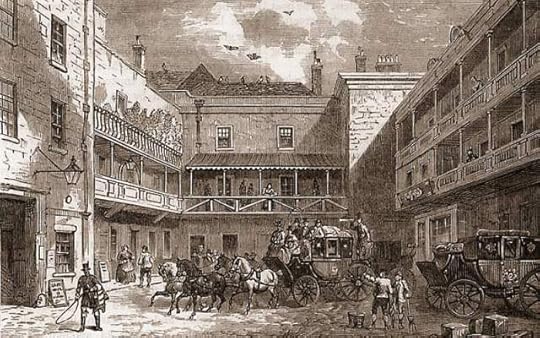
A typical coaching inn courtyard (Swan with Two Necks Inn pictured) from Principal Departures for London Coaches(1819)-Wicked William
https://www.wickedwilliam.com/princip...
 Types of Transportation Mentioned
Types of Transportation MentionedStagecoach: a four-wheeled public transport coach carrying paying passengers, luggage, and sometimes mail, drawn by four to six horses. See photo in last comment.
Post-chaise: a closed, four-wheeled coach or carriage drawn by fast horses, which were changed at each post.

https://en.wikipedia.org/wiki/Post_ch...
Gig: a light, two-wheeled spring cart pulled by one horse.
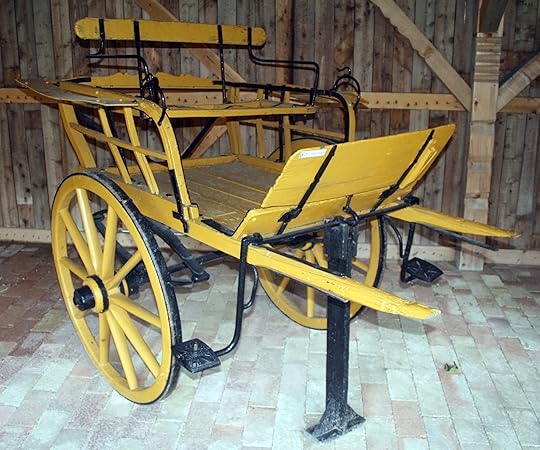
https://en.wikipedia.org/wiki/Gig_(ca...
Does anyone have a first impression of the play?
WOW Connie - You're really excelling yourself with this read! Thank you so much for providing so much interesting and attractive material! I'll message the group to remind them of what they might be missing (we have just 27 in this read so far).
My first impression was the cast list! Did anyone notice how very detailed the costumes were for each individual gentleman, but cursory and more general and "of a type" for the ladies?
Charles Dickens was always a dandy, and it's clear here that he is very interested in fashionable clothes from his own point of view as a young man-about-town. Playwrights don't often bother much to specify this aspect (although they might give general instructions as to a set design) and I think it's also unusual to favour men's costume rather than women's!
Like you Connie, I was struck by the joke, and how it tells us immediately that we are in the area of a farce. It also reveals a good grasp of relationships between couples, expressed in a comically cynical way.
This may have been this first time some people in the audience had come across the young Charles Dickens. He was 24 years old, and remember he had not yet published any of his novels! In 1836 he was in the middle of The Pickwick Papers, and was known as "Boz". (Those involved in our group read of Oliver Twist will no doubt remember that his name was only revealed to the public the next year, part way through that!) The Great Winglebury Duel was authored by "Boz". Do you happen to know from your own research Connie, whether this play was also attributed to "Boz" when it was first performed at St. James' theatre?
So from this beginning to the play, we get a good idea of the public's idea of the young man who was Charles Dickens. Not yet a great author by any means, but some who had written comic sketches, as Connie mentioned, had a wicked sense of fun, was very observant of people for his age, and well up with (and interested in) the latest styles in men's fashion.
My first impression was the cast list! Did anyone notice how very detailed the costumes were for each individual gentleman, but cursory and more general and "of a type" for the ladies?
Charles Dickens was always a dandy, and it's clear here that he is very interested in fashionable clothes from his own point of view as a young man-about-town. Playwrights don't often bother much to specify this aspect (although they might give general instructions as to a set design) and I think it's also unusual to favour men's costume rather than women's!
Like you Connie, I was struck by the joke, and how it tells us immediately that we are in the area of a farce. It also reveals a good grasp of relationships between couples, expressed in a comically cynical way.
This may have been this first time some people in the audience had come across the young Charles Dickens. He was 24 years old, and remember he had not yet published any of his novels! In 1836 he was in the middle of The Pickwick Papers, and was known as "Boz". (Those involved in our group read of Oliver Twist will no doubt remember that his name was only revealed to the public the next year, part way through that!) The Great Winglebury Duel was authored by "Boz". Do you happen to know from your own research Connie, whether this play was also attributed to "Boz" when it was first performed at St. James' theatre?
So from this beginning to the play, we get a good idea of the public's idea of the young man who was Charles Dickens. Not yet a great author by any means, but some who had written comic sketches, as Connie mentioned, had a wicked sense of fun, was very observant of people for his age, and well up with (and interested in) the latest styles in men's fashion.
Books mentioned in this topic
The Strange Gentleman (other topics)Noises Off: A Play in Three Acts (other topics)
Noises Off: A Play in Three Acts (other topics)
The Strange Gentleman (other topics)
Oliver Twist (other topics)
More...
Authors mentioned in this topic
Michael Frayn (other topics)Michael Frayn (other topics)
Charles Dickens (other topics)
Robert C. Hanna (other topics)
Judith Flanders (other topics)
More...



